The final set of photos includes miscellaneous shots of Pyongyang, including the Kimjongilia Exhibition Hall,
the Pyongyang Indoor Ice Rink and the Victorious Fatherland Liberation War
Museum.
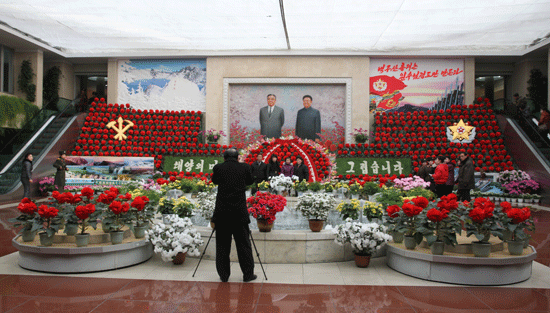
We visited the Kimjongilia Exhibition Hall on the 17th,
which was also a public holiday. The hall housed a gallery of flower sculptures
given to North Korea by various foreign governments and institutions, and all prominently
featured the vivid red Kimjongilia.

It was very crowded in the exhibition hall and we only had
time to walk around the pavilion once, which meant shuffling from sculpture to
sculpture while herded in the direction they wanted us to go. There were two floors of dioramas of factories,
rockets, and snowy landscapes. Every
single one of them was decorated with the same flower.

This would have been boring were it not for the hundreds of soldiers
who were also paying a visit to the hall that day. Most had come in from rural areas in the north for a special holiday trip to the capital. I noticed that on the whole they were rather short.
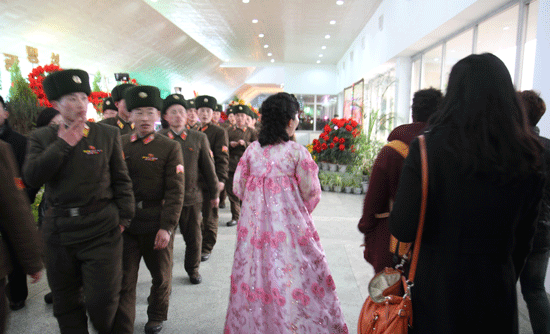
Our tour guide [middle] dutifully ignored
the stares our group was attracting, but there was no way to escape the fact that
we were turning heads. Although we had been told not to take photos of any soldiers
during our trip, it was impossible not to catch some in the shots we
took at the exhibition hall.
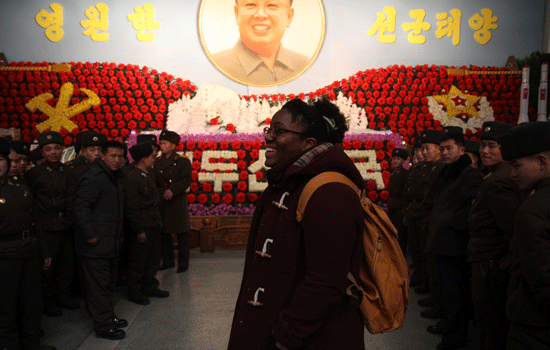
A very large crowd of soldiers had gathered by one of the largest sculptures. When
they noticed our tour group, someone called for them to make some room so that
the foreigners could take a group photo in front of the sculpture. What
happened next was like the parting of the Red Sea. The soldiers all grew quiet and made way for
us. It was one of the most awkward
scenes I have ever been a part of.
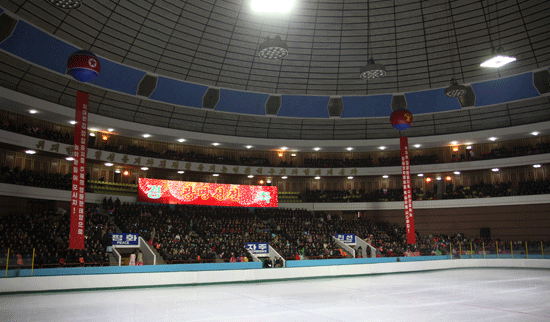
After the flower exhibition, we watched the closing ceremony
of the 23rd Mt. Baekdu Prize International Figure Skating Festival
at the Pyongyang Indoor Ice Rink.
It was no Olympics, but the performances were enjoyable. It was easy to just sit back and enjoy the figure
skating; to forget where I was and ignore the propaganda banners hanging
from the ceiling. I remember thinking it was a positive thing that Pyongyang was
engaging in sports diplomacy, although the crowds were obviously much more
enthusiastic about the North Korean performances than any of the others.

The North Korean
performances were distinguishable by the nationalist music and the backdrops of
fireworks and military formations, which was slightly off-putting and quite
different from the rest of the program.
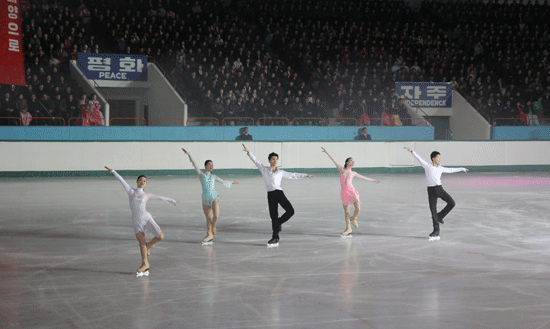
Our group was
surprised when a Russian pair skated to Lana Del Rey’s “Young and
Beautiful.” Until that point, the music
had been classical or instrumental and certainly not as blatantly American as
this song was. Other surprises included
a Latvian solo performance to “Part of Your World” from the stage version of The
Little Mermaid, and another solo performance to what was unmistakably an
instrumental version of Rihanna’s “Rude Boy” (although the translated title in
Korean was “Rhythm”).

That afternoon, our
group had a great opportunity to try the ice for ourselves at a public skate rink. Ice skating and rollerblading are currently very popular in Pyongyang.
The rink was chaotic and way over capacity, but it was very fun. With so many
people around and nobody watching us, it was easy to be silly, skate in
circles, slip and fall, and talk to strangers. In a complete reversal from the
situation at the exhibition hall, we actually seemed to blend in. It was a rare
chance to do something normal by North Korean standards, and I made the best of
it by striking up a conversation with a man I noticed curiously glancing over
at our group.
I planted myself next to him and introduced
myself. For the next half hour, we chatted in mixed Korean and English,
starting with the typical, “Your Korean is very good! Why are you learning it?”
He was a physics student at Kim Il Sung University and, “thanks to the
benevolent leadership of Kim Jong Eun,” was working hard toward his degree. He
was very amicable and excited to meet my American friends, whom I introduced
just before we had to leave. I wish that we had exchanged contact information
or even taken a photo together, but we were in a hurry, so I just said goodbye and
he skated away.
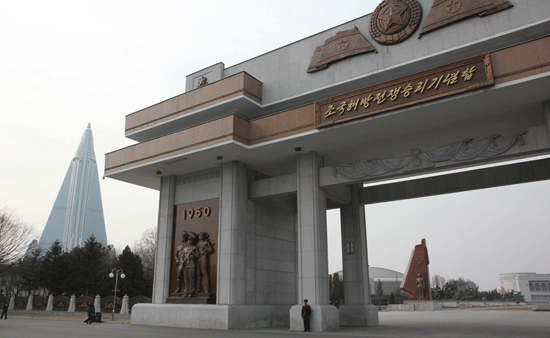
On the last full day
of our trip, our group visited the Victorious Fatherland Liberation War Museum.
It had been renovated last July and the new wing of the museum was opulent and
quite stunning. This photo shows the entrance gate to the museum as well as the
unfinished Ryugyong Hotel in the distance.

Our tour guide began
by providing us with information on the Korean War with this outdoor display of
enemy guns, tanks, planes, and other vehicles and equipment. I found it amusing at first that battle debris from the war had been proudly put on display here, but as we progressed I saw the wreckage
of a helicopter that had been captured in the 1960s, as well as other “trophies” taken
from as recently as the 1990s. This made it clear that the North Koreans believe
America is still an aggressive enemy that sends spy ships and aircraft.
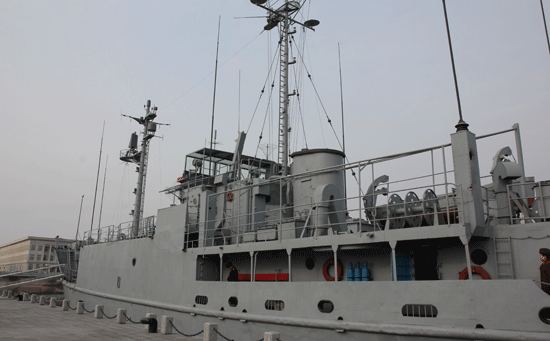
The star of the show
was the USS Pueblo, captured in 1968. It is permanently docked next to the
museum and a propaganda video inside lauds the efforts of the North Korean military
in teaching the United States a lesson about infringing on the sovereignty of
other nations. Bullet holes
made by the attacking Korean soldiers were circled in red and photos of the
captured (and one killed) American soldiers were on display. The incident had
been transformed into fodder for the North’s ceaseless anti-American rhetoric.
The framing of the USS Pueblo incident paled
in comparison to the museum itself. Photography was expressly forbidden inside,
so I can only use words to describe it.
The exhibits employ
advanced technology such as motion-controlled lighting and sound effects,
interactive maps, and realistic life-sized dioramas of destroyed buildings,
pillaging tanks, and grim-faced North Korean soldiers. I thought to myself, “Well,
why wouldn’t anyone believe the half-truths they’re told here?” Stunning
visuals in a recreated underground battle bunker and a 360 degree
revolving panorama of the Battle of Daejeon certainly create a convincing narrative for
visitors.
Our well-trained and
rather severe museum tour guide led us past diagrams of the advances made by
the Korean People’s Army in the early months of the war, and spoke grandly of
General Kim Il Sung’s military prowess. There was no mention of the role China
and the Soviet Union played in the war, and very little information about the
years following the landing of United States forces at Incheon. The rest of our
tour focused on the heroic acts and survival strategies of KPA soldiers after
the tide had turned and they had to struggle through brutal winters. We passed
a hall dedicated to war heroes, and I kept thinking, “This museum is enormous – how much more is there to
see?” We weren’t shown even half of it in the afternoon we spent there.

It was certainly odd
to hear our museum guide constantly refer to the United States and South Korea
as “the enemy”. I wondered if she ever thought her tour group, many of whom
where Americans and Korean Americans, would take offense.
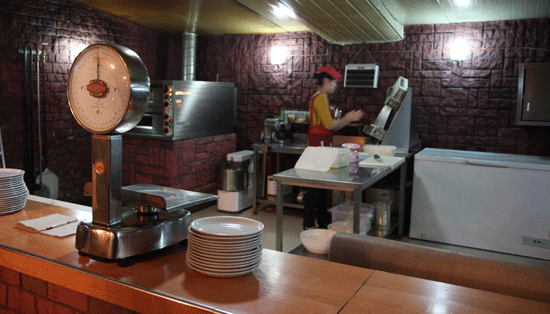
Our tour group ate its
final meal in Pyongyang at a pizzeria. As the story goes, Kim Jong Il visited
Italy and became inspired to bring its cuisine back to his country. He sent a
family to Italy to train for several years in the art of pizza making. There
are now two pizzerias in Pyongyang and it is said all of the ingredients they
use are imported directly from Italy.

It wasn’t bad!

The last photo I took
was of our Air Koryo plane at the Beijing Airport. Upon returning to a country
with [almost] unrestricted internet access I experienced a tinge of culture shock
and realized what a week in the Hermit Kingdom could do to your perspective on the
world. My view of North Korea has forever changed.




















